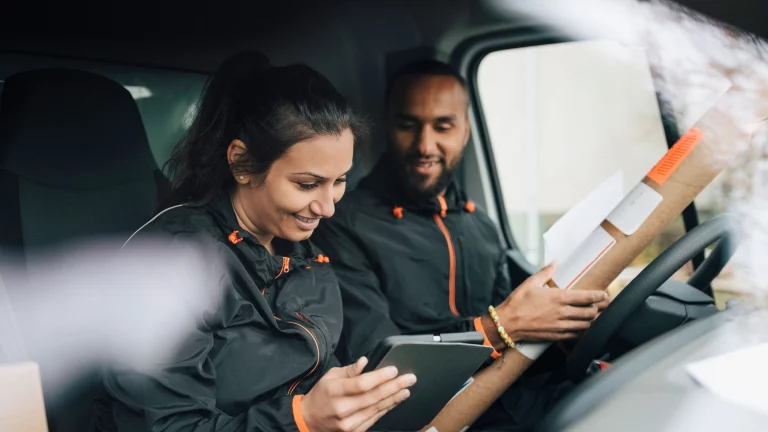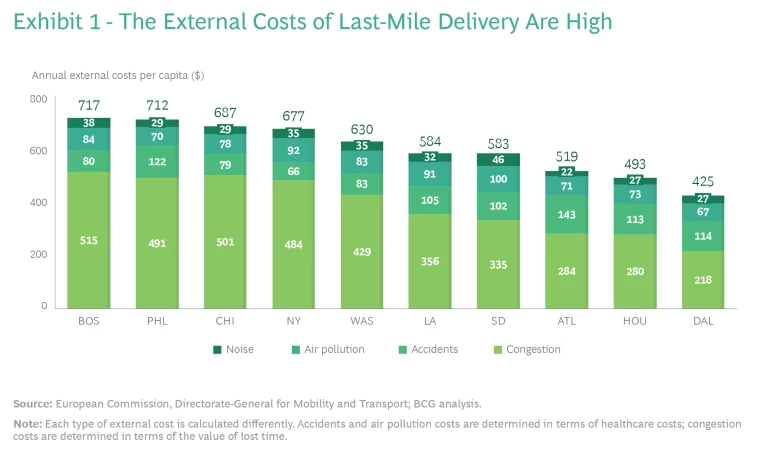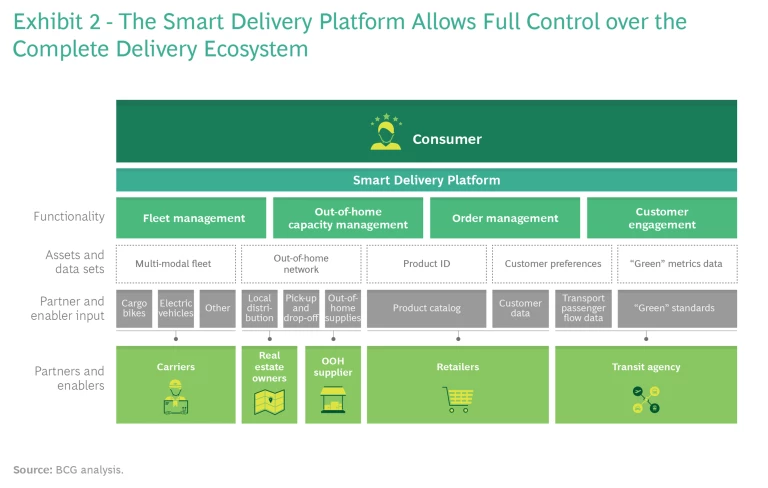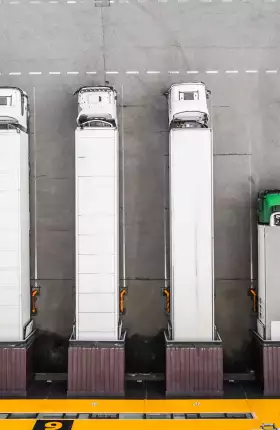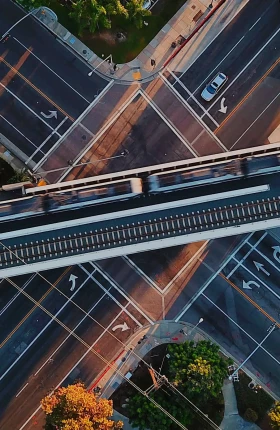The COVID-19 pandemic has triggered a massive shift among consumers to e-commerce. Online sales in the US were 44% higher in 2020 than in 2019, while in the UK, e-commerce sales in the first quarter of 2021 were 74% higher than in the same 2020 period. By 2025, the number of packages delivered around the world is expected to climb to 200 billion, up from fewer than 90 billion in 2018.
Unfortunately, while consumers may support environmental issues in general, price and convenience remain the overriding factors in their delivery choices. Few consumers consider the environmental and social consequences of delivery options. And while there is some dispute over how e-commerce compares to traditional retail with regard to emissions, the cost of the congestion, accidents, deteriorating infrastructure, and pollution caused by thousands of delivery vans plying the streets of the world’s major cities is unsustainable.
Reducing these costs will require developing a system that expands package delivery options beyond the home. At the same time, it must take into account the current and future roles and requirements of the delivery companies and retailers whose businesses depend on the system. This in turn will require collaboration, compromise and compliance among all stakeholders in the postal and parcel industry, to ensure that no player seeks to take advantage of the system. And it must be designed in light of a detailed understanding of evolving customer behavior, their needs, preferences and pain points. Here’s how.
A Bumpy Ride
The great drawback of last-mile delivery is its inefficiency, which threatens both the environment and the social benefits the industry provides. Thousands of last-mile delivery vans crisscross our cities, overlapping on every block every day. To satisfy increasing consumer demand for next-day and same-day delivery, carriers frequently send trucks to the same home several times a day, and different carriers deliver multiple packages to the same address. The huge spike in volume during the COVID-19 pandemic has put enormous pressure on carriers and their workforce.
To satisfy increasing consumer demand for next-day and same-day delivery, carriers frequently send trucks to the same home several times a day, and different carriers deliver multiple packages to the same address.
The impact on cities—from the sheer volume of packages delivered, the growing number of vehicle-miles traveled, and the delivery industry’s inherent inefficiency—is real. In the US, the external costs of last-mile delivery range from a high of $717 per capita in Boston down to $425 in Dallas. (See Exhibit 1.) Because last-mile delivery companies do not directly bear the cost of these externalities, however, they don’t factor them into the cost of doing business. They will send out enough trucks to meet customer demand, which may be more than is socially optimal, considering their impact on cities and neighborhoods.
So far, efforts to solve the problem of external costs have focused on making delivery companies contribute to paying those costs, through direct taxes on shipping or charging for access to the streets. While such solutions can ease the financial burden on cities, they do little to address the underlying business problem: the inefficiencies inherent in current urban delivery networks that propel those external costs.
A coherent solution to the problem at hand must therefore be conceived as a business ecosystem—a collection of largely independent economic players that come together to solve the problem to the mutual benefit of all.
Clearing the Streets
Consumers have long been sold on the notion that convenience should be a primary consideration in all their online activities, especially shopping. At the same time, there are signs of dissatisfaction with home delivery. In a recent BCG survey, most respondents reported some issues, including concerns over multiple daily deliveries and their inability to control the delivery process. And two-thirds were open to alternative delivery solutions. This provides an opportunity to devise a more efficient delivery system that gives consumers convenient out-of-home pickup options while integrating the activities of all players in the system. Key elements of the system include:
- Out-of-Home Delivery Network. A network of convenient destinations that meet customers’ delivery and return needs, with additional services to make shopping online even easier for everyone. These would vary in size: Large ones located in shopping centers and other frequently visited spots could offer convenient services such as package wrapping, labeling and mailing. Medium-sized locations in high-street shops such as coffee or flower shops would provide pick-up and drop-off services. Small pick-up lockers could also be placed in community hubs such as parks and recreational areas, based on demand and foot traffic. Ensuring security would be key to their popularity.
- Green Certification. Cities should develop transparent, common-sense, environmentally friendly standards covering the entire delivery network, including green fleets and sustainably operated out-of-home PUDO points. By providing consumers greater visibility into carriers’ practices, this option would promote greater awareness of the tangible impact of carriers’ delivery practices and build trust that the companies they’re buying from are doing everything they can to create sustainable delivery options.
- Smart Platform. Carriers, e-commerce companies and cities should work together to implement a single smart platform that would integrate all delivery and PUDO options and provide a single view of e-commerce customers. This would allow consumers to choose the most suitable options for them and consolidate their multiple deliveries. Shipping companies could merge their delivery schedules and map the best routes, and e-commerce companies could offer their customers a much-improved shipping and delivery experience. (See Exhibit 2.)
How It Can Work
The task of weaving these three elements together into a coherent ecosystem must be carried out by an independent orchestrator. Its task: to define strategy, create the required delivery network and software platform, decide the roles and rules for each stakeholder, set incentives for participation, and ensure open access for competing market participants. The orchestrator—most likely either a public entity or a well-defined public-private partnership—would coordinate all stakeholders, not just the carriers but also the city transport authorities and governing councils that might be needed to put the new ecosystem into practice.
The ecosystem we envision would require a significant shift in the role of the carriers. It would be up to the orchestrator to make clear the efficiency gains available in the new systems, and to encourage their participation through incentives.
This aspect of the new ecosystem is certainly the most challenging, given how large and fully embedded in communities the delivery companies have become. Yet it is critical to the plan. Without the proper set of incentives, as package volume continues to rise, carriers will simply flood the streets with more and more trucks. Yet carriers have much to gain from the properly managed delivery ecosystem of the future.
Delivering the Benefits
The primary goal of the new delivery ecosystem is to offer consumers a range of options that work for them, while increasing efficiency and reducing externalities. It would let consumers consolidate all their orders through personalized, one-click delivery solutions, and provide a network of convenient and attractive pick-up locations. Other benefits include transparency into the environmental and social impacts of their choice of delivery option and the availability of additional valuable services.
Just as important are the benefits such an ecosystem would offer to the other stakeholders in the delivery ecosystem.
- Carriers. Based on the results of top-performing carriers in leading markets, we believe that developing a new ecosystem will significantly benefit carriers. For example, a shift by consumers to OOH delivery, and of carriers to facilitating delivery to OOH options, would lead to an estimated 66% decline in carrier vehicle miles. The resulting gains in efficiency would be significant: a 15% decrease in the cost of each package delivered, even as carrier revenues increase in line with the further growth of e-commerce. Giving consumers visibility into their green delivery options would also enable carriers that can demonstrate their environmental credentials to gain market share. And it would mitigate the risk of regulators sanctioning less efficient carriers or taxing the use of city streets for package delivery.
A shift by consumers and carriers to OOH delivery would lead to an estimated 66% decline in carrier vehicle miles and a 15% decrease in the cost of each package delivered.
- Online retailers. Major e-commerce companies are already responsible for integrating the delivery options they offer customers, and often handle delivery tracking, inquiries and complaints themselves. By actively participating in the new ecosystem, they can improve their basket conversion rate and incremental revenue. Like the carriers, they can also bolster their brand’s green credentials by providing more sustainable delivery options. Greater sustainability can have a real impact on business performance, especially for companies in industries such as consumer packaged goods. Participation in the delivery ecosystem would also reduce their IT spending, thanks to greater economies of scale.
- Software providers. By acting as orchestrators, or simply creating and running the IT systems on which the ecosystem operates, software providers can capture some of the value they provide to other partners, in addition to charges for managing the system. Fees could be based on e-commerce companies’ savings on their IT costs, and on carriers’ reduced per-package delivery costs.
- Out-of-home suppliers. In addition to established retailers, new companies could arise to offer dense networks of OOH locations throughout cities. Revenue streams could include not just charging per-package fees to retailers and incumbent delivery companies, but also monetizing foot traffic. Space in their stores could be devoted to retailers’ pop-up stores and branded events. The data they capture about their customers could also be used to further promote their offerings and those of their partners.
- Real estate owners. Physical retailers and city transport authorities could benefit in several ways. In addition to the pickup fees they can earn, retailers can expect that as many as 30% of package pickups will lead to the purchase of something else. Transport hubs could rent space to OOH shops and capture further revenues from the rental of pick-up lockers.
The Road Ahead
The benefits of an integrated delivery ecosystem, we believe, are clear. Achieving it will take concerted effort, collaboration and compromise on the part of all the key players—city policymakers, carriers, and retailers. Specific steps include:
- Policymakers. First, determine the current nature of your city’s delivery network, and assess its inefficiencies and external costs, taking into account geography, population density, congestion data, infrastructure health, and the number of current carriers and their relative delivery densities—now and in the future. Second, design the delivery network and package of interventions needed to reduce the costs and inefficiencies. Third, develop a change management and implementation plan that will ensure the success of the new ecosystem in collaboration with all stakeholders.
- Delivery companies. First, engage with the orchestrators with an open mind, testing how your business model could change as profitability increases with the growth of e-commerce. Second, as orchestrated networks are established, adapt to the new model by competing primarily on the basis of efficiency of execution, while avoiding the need to add underutilized capacity to fulfill orders faster.
- Retailers. First, develop or adopt technical solutions that will allow your checkout processes to integrate with smart delivery platforms. Second, remember that customers value accessibility and are more likely to use a dense network of OOH options. Therefore, participate in fully open OOH delivery networks rather than in captive networks. Third, structure the checkout process to enable and promote green delivery options.
The benefits of an integrated delivery ecosystem are clear. Achieving it will take concerted effort, collaboration and compromise on the part of city policymakers, carriers, and retailers.
Cities of the Future
Despite rapid innovation in package delivery technology, it is unlikely that drones or other high-tech solutions will alleviate the negative externalities of last-mile delivery—the volume of deliveries and size of packages suggest delivery vans are a necessary element of delivery to home. Cities inundated by fleets of delivery vans must look to more down-to-earth solutions that are based firmly on how real people live and move around the neighborhoods and cities they live in.
But merely building a series of pick-up lockers won’t get the job done. Creating a new package delivery ecosystem offers cities the opportunity to rethink the value and role of individual neighborhoods, the economic viability of their commercial high streets, and the city’s overall mobility needs. Informed by the principles of speculative design, guided by an understanding of its social, economic, political and ethical impact, and carried out with imagination, package delivery design can play a key role in the regeneration of entire cities.
